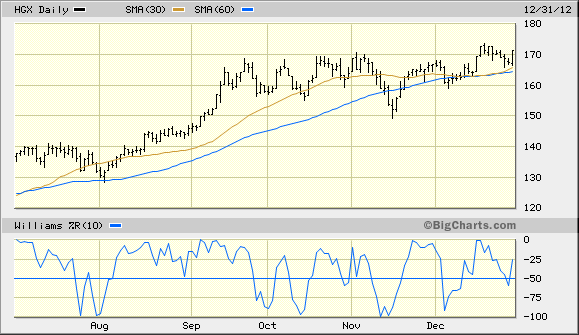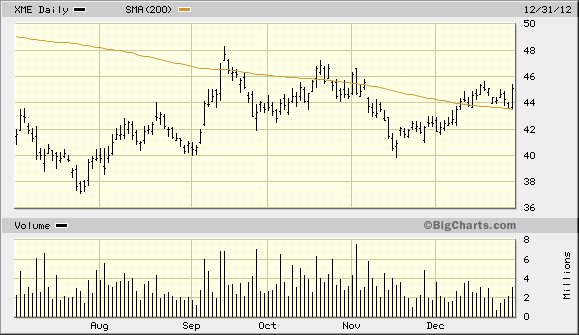Look at Financial Crisis Year 2013
Stock-Markets / Financial Markets 2013 Jan 02, 2013 - 02:34 AM GMTBy: Clif_Droke
 In the course of history, some of the great crises of the past were beyond the pale of human control. Other crises, however, were created by the very people who suffered the effects of them. The coming year could well afford a testament in how a “crisis of our own making” leads to economic destruction.
In the course of history, some of the great crises of the past were beyond the pale of human control. Other crises, however, were created by the very people who suffered the effects of them. The coming year could well afford a testament in how a “crisis of our own making” leads to economic destruction.
We have an excellent example of a created crisis in the ongoing fiscal cliff debate in the U.S. Congress. The debate centers on whether or not Congress intends to extend the Bush-era tax cuts or allow taxes on the middle class to rise in 2013. This is no small consideration, for if taxes are allowed to increase in the coming year it would mean almost certain death to the 4-year economic recovery. Investors would also likely suffer.
Even if a compromise is soon reached which prevents middle class taxes from rising, the very fact that Congress is struggling with an issue as simple as this – namely, the truism that rising taxes in a recessionary environment are contractionary in nature – displays an appalling lack of understanding among our elected leaders. Is it any wonder that many Americans are fed up with the dearth of political and economic wisdom to be found in the nation’s capital?
Moreover, the ongoing fiscal cliff debate is another piece of evidence that the next major economic crisis is likely to be political in origin instead of financial. The previous crisis of 2008 was of course a financial event which began in the housing sector and extending to the credit market. Linear extrapolation leaves much to be desired as a market forecasting tool. This is one reason why scientists and economists (who are the chief exponents of linear forecasting) often miss their predictions. But when applied to the realm of politics, linear extrapolation is one of the most accurate forms of prediction there is. This is because government and bureaucracy, by very nature, are imminently predictable. The men and women who fill the roles of elected officials aren’t forward thinking and are more apt to be reactionary rather than proactive. That is, politicians invariably respond to crises with after-the-fact remedies which rarely address the underlying causes of the crises and often do more harm than good. Because politics and bureaucracy move with all the speed of a glacier, you can see the trends emerging within this sector from miles away and easily predict what’s coming next.
The next major crisis will undoubtedly originate within government itself. Short-sighted politicians in European and Middle East countries have already shown the blueprint for engineering economic calamity in the face of a worldwide deflationary undercurrent. Even if the U.S. Congress manages to dodge the fiscal precipice in early 2013, there are myriad opportunities for them to wreak economic havoc in the coming year. Indeed, the temptation to embrace counterproductive policies in the hopes of stimulating the economy a’ la Europe is ever present. It would be surprising indeed if Washington manages to dodge a self-inflicted economic crisis in 2013, especially as the major yearly Kress cycles are all in the “hard down” phase until late 2014.
Let’s now take a look at what some of the leading minds on Wall Street have to say about the 2013 outlook. Echoing our sentiment for a “crisis of their own making” in 2013, veteran market forecaster Bert Dohmen of The Wellington Letter (www.dohmencapital.com) observed in a recent newsletter:
“There are two things that Congress will not do anything about, because they are either clueless, or personal ideology prevents them from doing so. The economic cliff is a recession. The economy has been slowing for over 15 months. That trend will continue, especially if major tax hikes are a price for averting the cliff. A recession will cause an acceleration of debt.”
Dohmen also made reference to a “corporate earnings cliff,” which he believes will occur if economic growth goes into contraction. “The stronger, recent earnings have been the result of big cost-cutting,” he wrote. “As they say, you can’t cut your way to prosperity.”
On an intermediate-term basis, one bright spot on the horizon is the U.S. housing market. Many respected real estate analysts have gone on record as predicting a continuation of the real estate recovery for 2013. Diane Swonk, chief economist at Mesirow Financial, believes that housing will continue to be on the mend this year. She writes, “Remodeling is up, and spending on [hurricane] Sandy recovery will enhance the trend, which is a plus for building materials and housing-related durables – appliances, carpeting, and furniture.”
Robert Campbell, editor of The Campbell Real Estate Timing Letter (www.RealEstateTiming.com) correctly predicted the 2007-2008 housing market collapse. He now sees a recovery well underway for California real estate, and subsequently U.S. real estate. In a recent issue of his newsletter he concludes, “While there are many contributing factors to the current housing recovery, I am of the belief that the recent gains in housing prices are in large part due to Fed policy. Not only have their actions pushed mortgage rates to record lows – which have increased demand – but the Fed is also allowing the banks to keep millions of foreclosed properties on their books until they want to bring it to market – which has decreased supply. Whether future price increases turn out to be small or large for the U.S. housing market, the current trend is pointing toward higher valuations ahead.”
The potentially bullish intermediate-term continuation chart pattern in the Housing Index (HGX) suggests that Campbell’s and Swonk’s forecast could be correct, at least for the first half of the year.

There is reason to believe that as we head further into the second half of 2013, however, that even real estate will begin to feel the pinch of a slowing economy as the Kress cycles descend ever closer to the 2014 bottom. One person who doesn’t share the rosy view for real estate in 2013 is Robert Shiller, the famous economics professor at Yale University and co-creator of the S&P Case-Shiller home price indexes. Shiller believes the inventory of potential foreclosures remains a threat across the U.S., especially if the economy slows.
At least one respectable analyst, who has a strong long-term track record for accuracy, believes the metals and mining sector could do well in 2013. Michael Cintolo, editor of Cabot Market Letter (www.cabot.net) recently observed, “Materials stocks (coal, steel, iron ore, etc.) had a horrible 52% drop from early 2011 through the middle of [2012], but have been etching a bottom for months; they’re now working on breaking above their 200-day moving average for the first time since September 2010.” See the SPDR S&P Metals & Mining ETF (XME) chart shown below.

While there are some special situation and profitable sector possibilities for 2013, investors would do well to remember that, as the year progresses, the longer-term Kress cycles will create increasing economic headwinds. The year could come to resemble 2007 in its volatility. More importantly, 2013 will serve be the gateway for the revolutionary 120-year cycle bottom scheduled for late 2014. It promises to be an eventful, fast-paced year and undoubtedly the most economically significant one since 2008.
2014: America's Date With Destiny
Take a journey into the future with me as we discover what the future may unfold in the fateful period leading up to - and following - the 120-year cycle bottom in late 2014.
Picking up where I left off in my previous work, The Stock Market Cycles, I expand on the Kress cycle narrative and explain how the 120-year Mega cycle influences the market, the economy and other aspects of American life and culture. My latest book, 2014: America's Date With Destiny, examines the most vital issues facing America and the global economy in the 2-3 years ahead.
The new book explains that the credit crisis of 2008 was merely the prelude in an intensifying global credit storm. If the basis for my prediction continue true to form - namely the long-term Kress cycles - the worst part of the crisis lies ahead in the years 2013-2014. The book is now available for sale at:
http://www.clifdroke.com/books/destiny.html
Order today to receive your autographed copy and a FREE 1-month trial subscription to the Momentum Strategies Report newsletter.
By Clif Droke
www.clifdroke.com
Clif Droke is the editor of the daily Gold & Silver Stock Report. Published daily since 2002, the report provides forecasts and analysis of the leading gold, silver, uranium and energy stocks from a short-term technical standpoint. He is also the author of numerous books, including 'How to Read Chart Patterns for Greater Profits.' For more information visit www.clifdroke.com
Clif Droke Archive |
© 2005-2022 http://www.MarketOracle.co.uk - The Market Oracle is a FREE Daily Financial Markets Analysis & Forecasting online publication.



